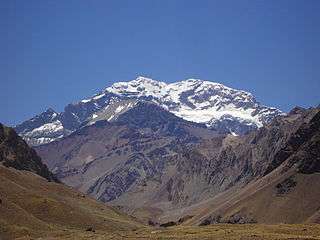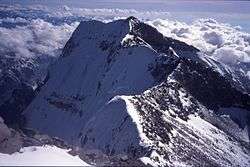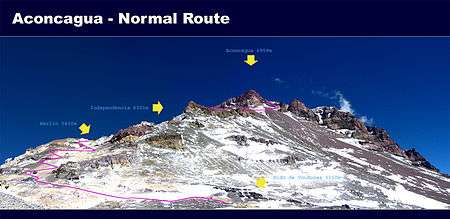Aconcagua
| Aconcagua | |
|---|---|
 Aconcagua from park entrance | |
| Highest point | |
| Elevation | 6,961 m (22,838 ft) [1] |
| Prominence |
6,961 m (22,838 ft) [1] Ranked 2nd |
| Isolation | 16,518 kilometres (10,264 mi) |
| Listing |
Seven Summits Country high point Ultra |
| Coordinates | 32°39′12.35″S 70°00′39.9″W / 32.6534306°S 70.011083°WCoordinates: 32°39′12.35″S 70°00′39.9″W / 32.6534306°S 70.011083°W |
| Naming | |
| Pronunciation |
Spanish: [akoŋˈkaɣwa] /ˌækəŋˈkɑːɡwə/ or /ˌɑːkəŋˈkɑːɡwə/ |
| Geography | |
 Aconcagua Argentina | |
| Location | Mendoza, Argentina |
| Parent range | Andes |
| Climbing | |
| First ascent |
1897 by Matthias Zurbriggen (first recorded ascent)[2] |
| Easiest route | Scramble (North) |
Aconcagua (Spanish pronunciation: [akoŋˈkaɣwa]) is the highest mountain outside Asia, at 6,961 metres (22,838 ft), and by extension the highest point in both the Western Hemisphere and the Southern Hemisphere.[1] It is located in the Andes mountain range, in the Mendoza Province, Argentina, and lies 112 kilometres (70 mi) northwest of its capital, the city of Mendoza. The summit is also located about 5 kilometers from San Juan Province and 15 kilometers from the international border with Chile. The mountain itself lies entirely within Argentina and immediately east of Argentina's border with Chile.[3] Its nearest higher neighbor is Tirich Mir in the Hindu Kush, 16,520 kilometres (10,270 mi) away. It is one of the Seven Summits.
Aconcagua is bounded by the Valle de las Vacas to the north and east and the Valle de los Horcones Inferior to the west and south. The mountain and its surroundings are part of the Aconcagua Provincial Park. The mountain has a number of glaciers. The largest glacier is the Ventisquero Horcones Inferior at about 10 kilometers long, which descends from the south face to about 3600 meters in altitude near the Confluencia camp.[4] Two other large glacier systems are the Ventisquero de las Vacas Sur and Glaciar Este/Ventisquero Relinchos system at about 5 kilometers long. The most well-known is the north-eastern or Polish Glacier, as it is a common route of ascent.
Origin of the name
The origin of the name is contested; it is either from the Mapuche Aconca-Hue, which refers to the Aconcagua River and means "comes from the other side",[3] the Quechua Ackon Cahuak, meaning "'Sentinel of Stone",[5] or Quechua Anco Cahuac, "White Sentinel"[6] or the Aymara Janq'u Q'awa, "White Ravine", "White Brook".[7]
Geologic history
The mountain was created by the subduction of the Nazca Plate beneath the South American Plate during the geologically recent Andean orogeny (mountain-building); but it is not a volcano.[8] The geologic history of the Aconcagua area can be classified into three basic time periods: a base that developed before the Jurassic Period of the Mesozoic Era, the Mesozoic sequences, and coverings from the Cenozoic Era.[3]
Climbing
.jpg)
In mountaineering terms, Aconcagua is technically an easy mountain if approached from the north, via the normal route. Aconcagua is arguably the highest non-technical mountain in the world, since the northern route does not absolutely require ropes, axes, and pins. Although the effects of altitude are severe (atmospheric pressure is 40% of sea-level at the summit), the use of supplemental oxygen is not common. Altitude sickness will affect most climbers to some extent, depending on the degree of acclimatization.[9] Even if the normal climb is technically easy, multiple casualties occur every year on this mountain (in January 2009 alone five climbers died). This is due to the large numbers of climbers who make the attempt and because many climbers underestimate the objective risks of the elevation and of cold weather, which is the real challenge on this mountain. Given the weather conditions close to the summit, cold weather injuries are very common.
The Polish Glacier Traverse route, also known as the "Falso de los Polacos" route, crosses through the Vacas valley, ascends to the base of the Polish Glacier, then traverses across to the normal route for the final ascent to the summit. The third most popular route is by the Polish Glacier itself.
No hard records are kept about Aconcagua ascents, but the Provincial Park reports a success rate of about 60% of climbers who attempt the mountain. About 75% of climbers are foreigners and 25% are Argentinean. Among foreigners, the United States leads in number of climbers, followed by Germany and the UK. About 54% of climbers ascend the Normal Route, 43% up the Polish Glacier Route, and the remaining 3% on other routes.[10]

The routes to the peak from the south and south-west ridges are more demanding and the south face climb is considered quite difficult.
The camp sites on the normal route are listed below (altitudes are approximate).
- Puente del Inca, 2,740 metres (8,990 ft): A small village on the main road, with facilities including a lodge.
- Confluencia, 3,380 metres (11,090 ft): A camp site a few hours into the national park.
- Plaza de Mulas, 4,370 metres (14,340 ft): Base camp, claimed to be the second largest in the world (after Everest). There are several meal tents, showers and internet access. There is a lodge approx. 1 km from the main campsite across the glacier. At this camp, climbers are screened by a medical team to check if they are fit enough to continue the climb.
- Camp Canadá, 5,050 metres (16,570 ft): A large ledge overlooking Plaza de Mulas.
- Camp Alaska, 5,200 metres (17,060 ft): Called 'change of slope' in Spanish, a small site as the slope from Plaza de Mulas to Nido de Cóndores lessens. Not commonly used.
- Nido de Cóndores, 5,570 metres (18,270 ft): A large plateau with beautiful views. There is usually a park ranger camped here.
- Camp Berlín, 5,940 metres (19,490 ft): The classic high camp, offering reasonable wind protection.
- Camp Colera, 6,000 metres (19,690 ft): A larger, while slightly more exposed, camp situated directly at the north ridge near Camp Berlín, with growing popularity. In January 2011, a shelter was opened in Camp Colera for exclusive use in cases of emergency.[11] The shelter is named Elena after Italian climber Elena Senin, who died in January 2009 shortly after reaching the summit, and whose family donated the shelter.[12]
- Several sites possible for camping or bivouac, including Piedras Blancas (~6100 m) and Independencia (~6350 m), are located above Colera; however, they are seldom used and offer little protection.
Summit attempts are usually made from a high camp at either Berlín or Colera, or from the lower camp at Nido de Cóndores. All camps are used frequently, namely Plaza de Mulas and Nido de Cóndores.

History
The first attempt to reach the summit of Aconcagua by a European was made in 1883 by a party led by the German geologist and explorer Paul Güssfeldt. Bribing porters with the story of treasure on the mountain, he approached the mountain via the Rio Volcan, making two attempts on the peak by the north-west ridge and reaching an altitude of 6,500 metres (21,300 ft). The route that he prospected is now the normal route up the mountain.
The first recorded[2] ascent was in 1897 by a European expedition led by the British mountaineer Edward FitzGerald. FitzGerald failed to reach the summit himself over eight attempts between December 1896 and February 1897, but the (Swiss) guide of the expedition, Matthias Zurbriggen reached the summit on January 14. On the final attempt a month later, two other expedition members, Stuart Vines and Nicola Lanti, reached the summit on February 13.[13]
The east side of Aconcagua was first scaled by a Polish expedition, with Konstanty Narkiewicz-Jodko, Stefan Daszyński, Wiktor Ostrowski and Stefan Osiecki summiting on March 9, 1934 over what is now known as the Polish Glacier. A route over the Southwest Ridge was pioneered over seven days in January 1953 by the Swiss-Argentine team of Frederico and Dorly Marmillod, Francisco Ibanez and Fernando Grajales. The famously difficult South Face was conquered by a French team led by René Ferlet. Pierre Lesueur, Adrien Dagory, Robert Paragot, Edmond Denis, Lucien Berardini and Guy Poulet reached the summit after a month of effort on 25 February 1954.[14][15]
The youngest person to reach the summit of Aconcagua was Tyler Armstrong of California. He was nine years old when he reached the summit on December 24, 2013.[16] The oldest person to climb it was Scott Lewis, who reached the summit on November 26, 2007 when he was 87 years old.[17]
In the base camp Plaza de Mulas (at 4300 meters above sea level) there is the highest contemporary art gallery tent called "Nautilus" of the Argentine painter Miguel Doura.[18]
In 2014 Kilian Jornet set a record for climbing and descending Aconcagua from Horcones in 12 hours and 49 minutes.[19]
The record was broken less than two months later by Ecuadorian-Swiss Karl Egloff, in a time of 11 hours 52 minutes, nearly an hour faster than Kilian Jornet.[20]
In popular culture
The mountain has a cameo in a 1942 Disney cartoon called Pedro.[21] The cartoon stars an anthropomorphic small airplane named Pedro who makes an air mail run over the Andes and has a near-disastrous encounter with Aconcagua (depicted in the film as an anthropomorphic menace). The mountain was featured in an illustration used when the story was collected in a Disney anthology book. It was also mentioned as the correct answer to a quiz show question in the 1969 Disney film The Computer Wore Tennis Shoes.
See also
Notes
- 1 2 3 "Informe científico que estudia el Aconcagua, el Coloso de América mide 6960,8 metros" [Scientific Report on Aconcagua, the Colossus of America measures 6960,8m] (in Spanish). Universidad Nacional de Cuyo. 2012. Retrieved September 3, 2012.
- 1 2 "There is no definitive proof that the ancient Incas actually climbed to the summit of the White Sentinel [Aconcagua], but there is considerable evidence that they did climb very high on the mountain. Signs of Inca ascents have been found on summits throughout the Andes, thus far the highest atop Llullaillaco, a 6,721-metre (22,051 ft) mountain astride the Chilean-Argentine border in the Atacama region. On Aconcagua, the skeleton of a guanaco was found in 1947 along the ridge connecting the North Summit with the South Summit. It seems doubtful that a guanaco would climb that high on the mountain on its own. Furthermore, an Inca mummy has been found at 5400 m on the south west ridge of Aconcagua, near Cerro Piramidal" R. J. Secor, Aconcagua: A Climbing Guide, The Mountaineers, 1994, ISBN 0-89886-406-2, p. 13.
- 1 2 3 Forbes, William (2014). McColl, R.W., ed. Encyclopedia of World Geography, Volume 1 Facts on File Library of World Geography. 1. Infobase Publishing. p. 3. ISBN 0816072299. Retrieved 23 September 2016.
- ↑ Servei General d'Informacio de Muntanya, 2002, "Aconcagua 1:50,000 map", published by Cordee
- ↑ "South American Explorer". South American Explorers Club (4-19). 1979. Archived from the original on 22 September 2016. Retrieved September 22, 2016 – via University of Texas.
- ↑ Secor, op. cit., p. 13.
- ↑ Guías Pedagógicas del Sector Lengua Indígena, Aymara Archived 27 September 2013 at the Wayback Machine. Ministerio de Educación, Fondo de las Naciones Unidas para la Infancia, UNICEF, Santiago de Chile, 2012 (Spanish), p. 62 Janq’u q’awa (Aconcagua: quebrada blanca).
- ↑ Simkin, T. and Siebert, L. (2002–). What is the world's highest volcano? Smithsonian Institution, Global Volcanism Program. Retrieved 22 August 2012.
- ↑ Muza, SR; Fulco, CS; Cymerman, A (2004). "Altitude Acclimatization Guide". US Army Research Inst. of Environmental Medicine Thermal and Mountain Medicine Division Technical Report (USARIEM–TN–04–05). Retrieved 5 March 2009.
- ↑ Stewart Green. "Aconcagua — Highest Mountain in South America".
- ↑ "TERMS AND CONDITIONS OF USE OF THE "ELENA" SHELTER – ACONCAGUA PROVINCIAL PARK".
- ↑ "Inauguración del refugio Elena".
- ↑ Fitzgerald, E. A. (1898). "On Top of Aconcagua and Tupangato". McClure's magazine. S. S. McClure, Limited. 12 (1): 71–78.
- ↑ R.J. Secor, Aconcagua: A Climbing Guide, The Mountaineers Books, 1999, pp. 17–21
- ↑ Mario Fantin, Some Notes on the History of Aconcagua, The Alpine Journal 1966
- ↑ "Nine-year-old US boy climbs Aconcagua peak in Argentina". BBC News. 28 December 2013.
- ↑ "Récord: un niño de 10 años hizo cumbre en el cerro Aconcagua" (in Spanish). Retrieved 26 October 2010.
- ↑ "Guinness World Records"
- ↑ "Kilian Jornet Smashes Aconcagua Speed Record". Climbing Magazine. 23 December 2014.
- ↑ "Aconcagua Speed Record Smashed Again". Climbing Magazine. 19 February 2014.
- ↑ "Pedro (1943)". IMDb. Retrieved 26 October 2010.
External links
| Wikivoyage has a travel guide for Aconcagua. |
| Wikimedia Commons has media related to: |
- Aconcagua in Andeshandbook
- "Aconcagua". SummitPost.org. Retrieved 26 October 2010.
- Centro de Investigación en Medicina de Altura (CIMA) de Aconcagua is an international consortium of high altitude researchers and mountaineers interested in improving the safety of mountaineers on Aconcagua and enhancing our understanding of the pathology of high altitude illness.
- Daily time lapse animations of the Aconcagua base camp Webcam
- Highest peaks on peakware.com
- Interactive Satellite / Terrain Map, Photos, and Information on climbing Aconcagua
- Live webcam from Aconcagua base camp (December to March)
- Aconcagua: Everyman's Everest